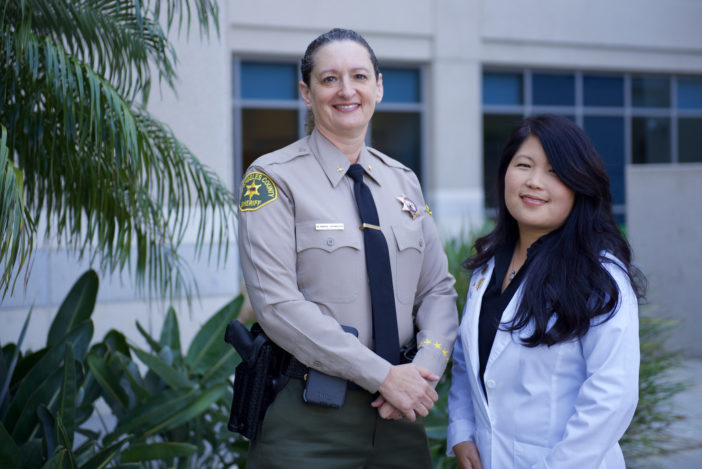When she got the call in April, she was in a meeting at the Century Regional Detention Facility in Lynwood, where she works.
She didn’t think anything of it – that is, until she heard her doctor’s voice.
“I knew it wasn’t good,” said Cheryl Newman-Tarwater, a commander with the Los Angeles County Sheriff’s Department. “He tells me, ‘Cheryl you have breast cancer.’ I couldn’t believe it. I could not believe it.”
Devastated, Newman-Tarwater heard her doctor saying one in eight women get breast cancer. And she realized she was the one.
Because she had a family history – her mom had breast cancer twice and her great-grandmother also had it – she was considered high risk. It’s because she was so high risk that her doctor had recommended her enrollment into the Hoag Early Risk Assessment (HERA) program back in 2014.
“I had been watched for years … mammograms, ultrasound, I had some biopsies,” she said.
In March, she received a call from a nurse practitioner about getting an MRI done as part of the HERA program – something she was encouraged to have due to her high risk.
“If there’s any cancer, it lights up,” Newman-Tarwater learned.
She said HERA had recently changed its protocol and called up women who hadn’t yet received their MRI – something Newman-Tarwater calls “miraculous.”
Timing was everything with the type of cancer Newman-Tarwater had. The small, invasive lobular carcinoma was detected with the MRI. But it was so small that during followup visits for a biopsy and ultrasound, “It was really hard for [the technologist]to find it when she was doing the ultrasound,” she said.
But it was found to be cancerous, and had just reached her lymph nodes. It was recommended she have a double mastectomy – which was done in June.
“I’m cancer free,” she said.
She attributes the success of the treatment to the HERA program and that call for the MRI. Her cancer was invisible on mammogram, which is a common feature of invasive lobular cancer; it’s often difficult to detect until the tumor is much larger.
“Then I would have been in a lot of trouble,” she said. “The HERA program was absolutely miraculous for me and for my family.”
Her doctor told her if the MRI had been done six months earlier, the cancer wouldn’t have been there yet.
“If it weren’t for the HERA program, I never would have had an MRI,” she said. “The timing was amazing.”
Now she’s working on paying it forward and telling as many women as possible to get regular screenings, including her female colleagues at the detention facility.
“I feel like I have to remind everyone, that in this day and age, no woman should die of breast cancer,” said Newman-Tarwater, who is also a spokeswoman for the Pink Patch Project, which raises funds for breast cancer research. “I was given a gift, a miracle, and I want to share that information with others.”
HERA, which is funded through philanthropic donations, is open to women 35 to 55 who come in for a mammogram screening at one of the Hoag facilities, according to Dr. January Lopez, breast radiologist at Hoag.
“In our first three years, there were about 2,000 women identified as being ‘high risk’ for developing breast cancer,” Lopez said of the HERA program. “These women were all notified of their risk assessment. Nine hundred and sixteen high-risk women underwent an in-depth consultation with our high-risk nurse practitioner, Karen Herold, and were provided counseling and resources about their high-risk status, like Cheryl.”
Through other programs – including HERA Under 40, in which the hospital is reaching out to younger at-risk women – they’re trying to expand those numbers.
“She was so fortunate that she was involved in the program,” Lopez said. “We want more. We want to help more people. We want to detect all the cancers when they’re curable.”
Follow Newman-Tarwater on Twitter at @cheryltarwater, where she promotes breast cancer awareness. Learn more about the HERA program at hoag.org/know-your-risk.
 Behind the Badge
Behind the Badge



